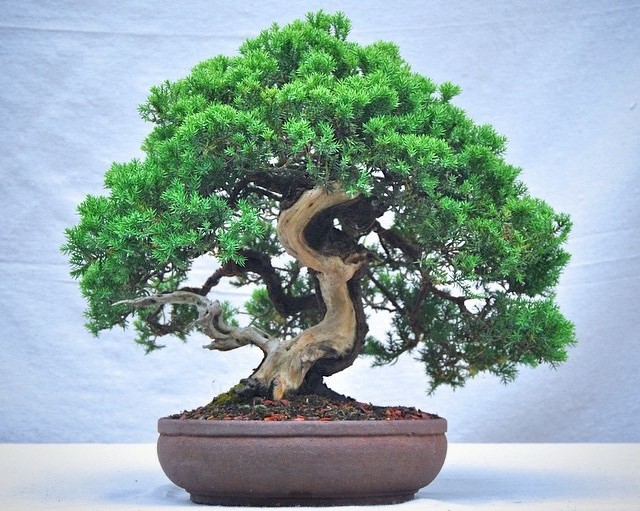
Unfortunately Junipers have been given a bad reputation, although they make some of the most beautiful bonsai you will have. They are the most common tree used for “consai” (conning you into thinking it is a bonsai). The market is full of Junipers stuck in a glazed pot with gravel glued on top. How many times have you heard someone say, oh I had a Juniper Bonsai and it died. Chances are it was already dead or dying when you purchased it, for it can stay green for quite some time after dying. Also some people only associate bonsai with a Juniper, and having had one die for them has turned them against bonsai. Of course it doesn’t help much when they keep the tree on their coffee table or desk.
I have had some people that have many bonsai say they don’t have any luck with Junipers and kill them. Junipers are very tough plants, but there are a couple of things that will kill them. One is Spider Mites, they will get them and you have to be proactive in keeping your trees free of them. Second is over watering, although a Juniper likes a lot of water through our hot summers, they do not like to stay wet. Therefore they need to be in a very well draining soil, this is critical. Sometimes it can be hard to see that your tree has a problem before it is too late, that is why it is important to be vigilant on keeping up with their needs.
There are many species, varieties and cultivars of Junipers. We are only going to discuss a few of the most commonly used. It is important when choosing a Juniper for bonsai you know the species you are buying, for some back bud on old wood easier than others, some not hardly at all. Any of the chinensis varieties tend to back bud well.
Juniperus ‘procumbens nana’ Probably the most common used for smaller bonsai, although if you can find a large trunk on one it will make a beautiful specimen.
Juniperus prostrate A quicker growing Juniper that will develop a large spread, commonly found in nurseries or in your yard, might have a nice one in your or a neighbors yard worth collecting. With their spreading habit they can be used for a cascade.
Juniperus chinensis The most commonly used mainly for it’s ease in back budding. Best varieties are Shimpaku, Parsonii, and San Jose.
PRUNING... Junipers can be heavily top pruned and root pruned, though care must be given when root pruning. Do not saw the root ball for the delicate feeder roots are located at the ends of the roots and are easily damaged, instead cut the largest roots out with root pruners and then comb out the smaller roots.
TRAINING... Wiring is a must when training a Juniper, the more time you spend wiring the main and secondary branches in its initial styling and then over the next few years wiring its tertiary branching the nicer tree you will have. Keep all growth growing straight down and in between your branches pruned out.
LIGHT... Junipers prefer full sun, although in the heat of the summer I sometimes give them a break from the hottest afternoon sun.
FERTILIZE... Junipers are heavy feeders through the growing season. I use a time release fertilizer and twice monthly feedings of nitrogen, once foliar and once soil feeding. Periodically use a balanced fertilizer such as 20-20-20 with acid.
INSECTS... Red Spider Mites, they will get them and when infested can kill your tree sometimes before you even realize it. They occur mainly in the wet summer months and in the dry winter months. Once found you must use a miticide immediately and often to get rid of them. I use a systemic insecticide to prevent them from appearing. Weekly spraying using a strong spray from a garden hose is also a good preventative.
REPOT... Another way to kill a Juniper is to pot out of season, I repot my Junipers in February. Young trees may need repotted every two years, older trees can go 3-4 years. It is best to carefully remove all or most of the original soil when first potting, you do not want to create a wet ball around your roots. Use a very well draining soil.
SEASONAL... Junipers are cold hardy and can be left out year round here.


